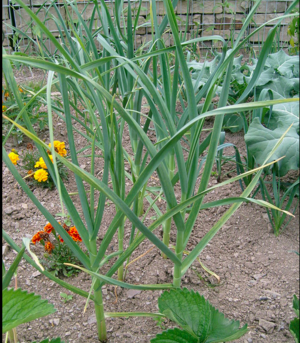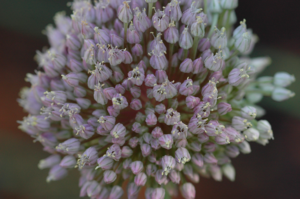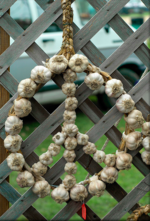
Garlic (Allium sativum, family Liliaceae) is part of the onion family and is one of the most widely used culinary herbs. It is a hardy perennial herb in the form of bulb.[1] A native of central Asia, it can now be found around most of the world.
The Anglo-Saxon (Old English) name for garlic was garleac, made from the word "gara" or "gar" (spear/lance) and "leac" (leek).[2]
It is widely used in Chinese, Indian, Asian and Mediterranean dishes and has been so used for about 5,000 years.[3] It has also been used medicinally for about the same amount of time.[3]
Description[edit | edit source]

Garlic has flat lightly colored green leaves. These grow to a length of approximately 30cm (12 inches) and measure around 2.5cm (1 inch) across.
Garlic segments are bulblets that form each bulb as a whole. Each bulblet is covered by a papery skin, usually white in colour but may also be pinkish, yellowish, etc. Culinary references to the bulblets usually use the term "cloves".
When garlic flowers, it produces a pompom style flower head which contains clusters of purplish-white, pink, green-white or white flowers. This grows on a stalk that reaches a height of around 60cm (24 inches), or higher.
There are two principal types of garlic grown for home use. The Allium sativum already mentioned and another garlic known as elephant garlic (Allium ampeloprasum).[1] Elephant garlic is milder than the other type of garlic and does not store well.[1] The bulbs vary in size and number of cloves depending on the variety of garlic, and the climate.[3]
Garlic grown in hot climates tends to be the sweetest in flavour.
Growing garlic[edit | edit source]
- Plant during mid-autumn or early spring. In some cases, it may be helpful to place the bulbs in a refrigerator or cold place for a week prior to planting out to provide a cold spell, especially if you've left planting until later spring when the ground has warmed up.
- Garlic planted late spring will not produce good bulbs. If you've left it this late, wait until autumn comes around.
- Choose the bulbs. Choose good quality bulbs that are clean, firm and in good shape. Do not plant bulbs that are stale/old, mouldy or soft.
- Break the garlic bulblets or cloves apart to break up the bulb. Each of these segments will be planted separately to grow as a distinct garlic plant.
- Prepare the soil. Dig the soil well; it should be crumbly. It helps to apply a complete fertiliser or well rotted organic matter before planting the garlic.[1] Garlic has high nutrient needs for good growth, so include around 10 to 15cm (4 to 6) inches of well rotted organic matter and all-purpose fertilizer.[1]
- Plant the clove. The pointed end should face upward, and be no more than 1 to 2 cm (1 inch) beneath the surface. Leave the papery skin on each clove being planted.
- If planting more than one, space the cloves at least 20cm (8 inches) apart.
- Cover with soil. Water in well. Garlic cloves generally grow fairly well in the right conditions. This means watering them regularly and ensuring that the soil remains rich. Mulch to keep in moisture, as needed. This also helps to smother weeds.
- Watering is a balancing act. The soil must remain moist but not wet; if it's wet the bulb will rot. If it is too dry though, the bulb will not form well.[4]
- Feed as needed. Garlic responds well to fertilising. Use a general garden fertiliser or complete plant food, especially if the plant growth seems poor.
- Weed with care. Only shallow weed, by hand, to avoid damaging the bulb with digging tools. Weeds are a problem with garlic because it doesn't produce lower level foliage to discourage the growth of weeds, so you must tend to this for the garlic.[4]
Garlic as a companion plant[edit | edit source]
Garlic may be a useful companion plant to ward off pests from the following plants:
- Roses
- Strawberries
- Cabbages
- Fruit trees
- Tomatoes.
Garlic may be unhelpful if planted near beans, peas and asparagus.
Harvesting garlic[edit | edit source]
Harvest garlic when the leaves have yellowed and the top of the stalk is falling over. If you pull the cloves out with the leaves, you can braid the leaves together for aiding aerial storage, a well-known and time-tested way of keeping garlic. Wash the bulbs after pulling out, to remove soil. Then allow the bulbs to dry in the sunshine to dry. String the garlic bulb stalks together at the top, then braid into a rope. Hang in a cool, dry place with good airflow. When needed, simply pull off single cloves to use.

Ensure that garlic is completely dry before storing it. If not, it can be a medium for the growth of mould or fungus.
You may wish to wear gloves when harvesting, if you don't want the odour to transfer to your hands. This is no different from cutting the cloves when cooking with garlic, however. Either you don't mind the odour, or you do!
Problems[edit | edit source]
- Garlic won't grow well if the climate is cold or constantly damp and lacking in sunshine. In this case, try only planting the cloves in early autumn.
- Garlic does not grow well in intense heat. It is not a suitable plant for growing in tropical climates unless grown under a shelter away from rainfall. In this case, plant in containers of sandy potting soil. The container should be deep.
- Insects that can be a nuisance to garlic include thrips and onion maggot.[1] Rotate the garlic and use appropriate sprays.
- Neck rot is a fungal disease that can affect garlic.[1] To avoid this, don't water a lot too close to harvest time.
- If the bulb is not harvested in time, the bulb tends to split. This makes retrieving the different bulblets more difficult. Moreover, over-matured garlic bulbs do not store well.
Do not freeze garlic bulbs. They do not freeze well and will be of no use when thawed.
Uses of garlic[edit | edit source]
Garlic has culinary, medicinal and companion planting uses.
Culinary[edit | edit source]
- Rub around the salad bowl to impart the flavour of garlic into a salad without actually adding raw garlic to the salad.
- Garlic goes well with meat, fish and vegetable dishes.[3] It is also good in salad dressing, sauces and egg dishes.[3]
Note: Not everyone enjoys garlic. On the other hand, some people can't get enough of it and will happily eat a chicken stuffed with 20 garlic cloves. It's a matter of personal taste and if having guests to dinner, err on the side on a touch of garlic rather than an overpowering amount in any dish.
Chew parsley to deodorise the mouth and lessen the smell of garlic.
Medicinal[edit | edit source]
- Garlic has antibiotic and antiseptic properties.[3]
- Garlic can clear infections in the lungs and can be directly applied to infected areas to provide anti-microbial benefits.[3]
Companion planting[edit | edit source]
- Plant garlic under and next to roses as a form of companion planting. It is used to help deter aphids and other pests that like roses.
- Plant garlic around carrots to deter carrot fly.
Sources and Citations[edit | edit source]
- ↑ 1.0 1.1 1.2 1.3 1.4 1.5 1.6 1.7 1.8 1.9 http://extension.usu.edu/files/publications/publication/HG_2004-02.pdf
- ↑ (Macdonald, 1981)
- ↑ 3.0 3.1 3.2 3.3 3.4 3.5 3.6 (Foley, et. al., 2001)
- ↑ 4.0 4.1 4.2 http://web.archive.org/web/20141014052422/http://www.ag.ndsu.edu:80/pubs/plantsci/hortcrop/h1409.pdf
- Christina Macdonald. (1981) Garden Herbs for Australia and New Zealand, ISBN 0-589-01409-9
- Caroline Foley, Jill Nice and Marcus A. Webb. (2001) "New Herb Bible", ISBN 1-875169-92-X